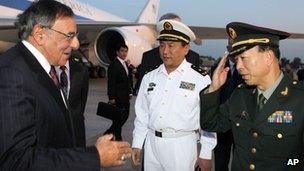China's concerns over US-Japan missile deal
- Published

Leon Panetta (L) is in China this week - his first visit to the country as US defence secretary
The announcement that the United States is to deploy a second advanced radar system in Japan is an effort to reassure the Japanese, who have become increasingly alarmed by North Korea's developing missile arsenal.
But it is also likely to raise concerns in China, which sees Washington's growing missile defence architecture in the region as a potential threat to its own strategic interests.
Japan already deploys ballistic missile defences. It has four Kongo-class destroyers with the Aegis battle-management system and standard missiles - similar to the aegis-equipped ships that form a key element of the US Navy's own anti-missile defences.
Batteries of the PAC-3 version of the Patriot surface-to-air missile system are deployed on land. Two more aegis equipped warships are planned along with more Patriot batteries.
North Korea is the prime threat against which Japan's missile defences are directed. There was outrage in Japan in 1998 when Pyongyang fired an intermediate-range ballistic missile over its territory.
This spurred Japan's interest in missile defences, which has crystallised over the past decade as North Korea has improved its missile arsenal. However China has watched these developments with growing unease.
Different approach
There are similarities here to Russia's unhappiness with US and Nato missile defence plans in Europe.
The West says that these are intended to defend against a limited missile attack from Iran. But Moscow worries about what implications developing missile defences may have for the viability of its strategic nuclear arsenal, and thus for the future of nuclear deterrence.
China's concerns are similar. It may well realise the limited nature of the current defensive screen in Asia.
But what, ask Chinese experts, might happen if missile defences were to be spectacularly successful? Surely they would expand and thus raise questions about the effectiveness of China's own deterrent forces?
But China also has another more pressing concern.
A central element of its maritime strategy is what is termed "area denial". It is Beijing's way of countering the dominance of America's surface fleet based upon highly-capable aircraft carrier battle groups.
Rather than deploying like-for-like vessels of its own, the Chinese have taken a different approach.
They are developing and deploying a variety of shore-based weapons capable of striking far out to sea, among them the DF-21D - a ballistic missile with a range of some 2,700km (1,678 miles). A highly-capable missile defence system - especially a mobile one based upon warships and backed up by land-based radars - could represent a significant counter to a weapon that some have dubbed "the carrier-killer".
If tensions are to be reduced, what's needed is for China and the US to have a better understanding of each others' strategic thinking. Closer military-to-military ties are one aspect of this.
The US Defence Secretary, Leon Panetta, will have an opportunity to explain to the Chinese the thinking behind Washington's limited missile defences when he visits Beijing this week. But just as in Moscow, the Chinese see missile defence through their own strategic prism and it is a very different viewpoint from that in both Washington and Tokyo.
- Published17 September 2012
- Published16 September 2012
- Published18 January 2012
- Published6 January 2012